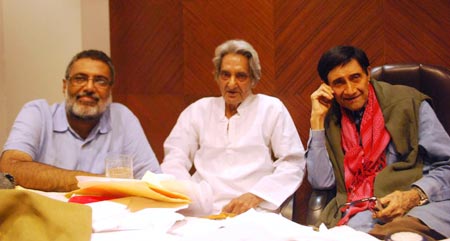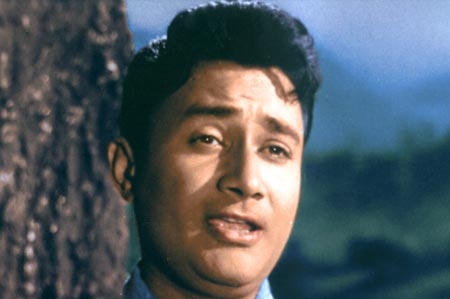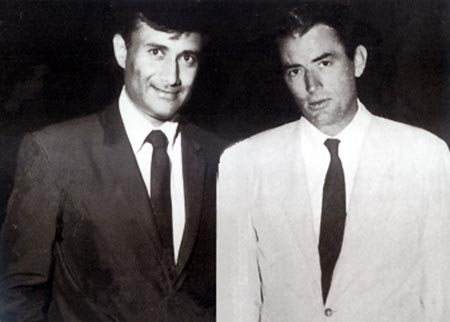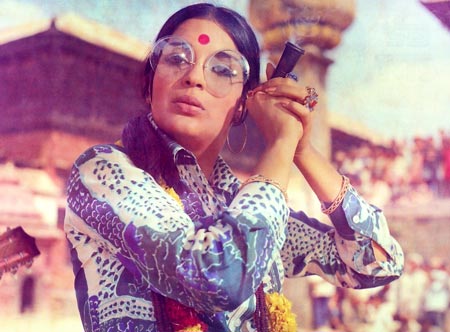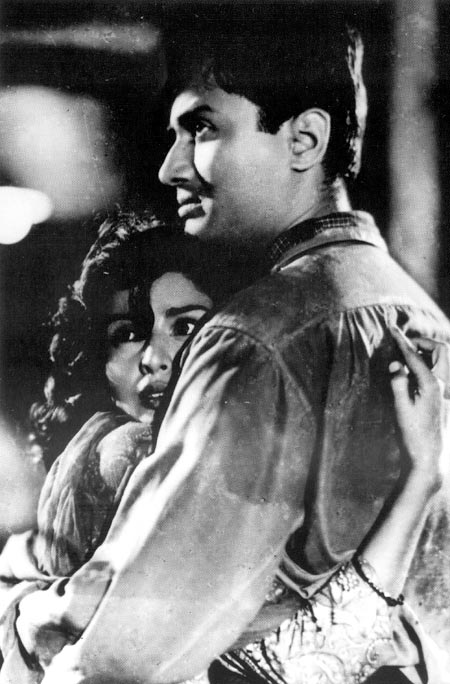 | « Back to article | Print this article |
How Dev Anand's Navketan changed Indian cinema
What exactly made Dev Anand such a big star?
What made his films so different from the ones being made at that time?
What role did his production house Navketan have in changing the face of Indian cinema?
Sidharth Bhatia tries to explain all this and more in his book, The Navketan Story: Cinema Modern.
He spoke to Rediff.com's Sonil Dedhia about the Magic of Dev Anand:
Your book talks about Dev Anand as the first modern hero. What went into the making of the modern hero?
Dev Anand was exposed to Western culture at a very early age. His father was a successful lawyer in Gurdaspur, a small town in Punjab, who believed in the British system of education. On the other hand, his mother had a contrasting mindset and subscribed to the Indian school.
Devsaab's elder brother Chetan Anand went to Gurukul Kangri to study Hindu scriptures. but at the same time, he graduated from an English government college in Lahore, where only the elite studied. The atmosphere was completely Westernised and they mixed with a smart, intellectual lot.
Devsaab followed his elder brother's footsteps and completed his education from Lahore. Then, he moved to Mumbai. He mingled with Chetan's friends, which included writers and intellectuals. This helped make up his mind and with the whole Western culture.
Another factor that contributed to his modern hero mindset was that Hollywood films heavily influenced Devsaab. In 1944, a new kind of Hollywood films was emerging. These films were gritty and dark, with morally ambiguous characters. Today, they are known as noir films and Devsaab was attracted to them.
In his personal life too, he was a modern man who wore stylish clothes and would stay away from anything traditional.
Modernity was very critical is his life and his films. That's why I call my book 'Cinema Modern.'
Please click Next to read further...
'Devsaab's characters were suave and debonair'
How did India, which had just won her Independence, identify with Dev Anand of the 1950s?
I suspect what must have happened is Navketan started making films, which urban India could relate to. As I said earlier, he was exposed to the city at an early age. He had a lot of friends in Mumbai who were influenced by Western culture.
Devsaab's associates Guru Dutt and Raj Khosla were very Western in their filmmaking as well.
In the early days, films were not pan India hits. They would work in pockets. Films like Baazi and Mother India were criticised in some parts of India.
With Kismet (1943), Ashok Kumar had re-written the rules of cinema by portraying the hero as a thief. The film ran for 188 weeks in Kolkata.
Dev Anand's Taxi Driver, I presume, is the first Hindi film to be shot completely outdoors in Mumbai.
I guess this film had done major business in Mumbai, Pune and major cities across India, but the film didn't click all over India.
I still feel Devsaab was among the first urban, Westernised heroes in Bollywood and the audience was able to connect to him.
Dev Anand was inspired by Hollywood noir. Did that add to his appeal?
It was because he came across as everybody's man. The characters he portrayed were always optimistic. In spite of misfortunes, his characters never felt dejected. Even if the heroine would reject him, he would make her swoon with his dapper look.
Every film had a song, which showed Devsaab in a happy-go-lucky mood. His characters had I-care-a-damn attitude and people loved that attitude.
His characters were suave and debonair. He had a particular way of wooing his heroines. The ultimate quality that Dev Anand had was he was a 'cool man' and the next 'cool man' came after him was Shammi Kapoor.
Please click Next to read further...
'Grey shades appealed to Devsaab'
Do you think Gregory Peck influenced Dev Anand?
No, I don't think so. Gregory Peck does not walk the way Devsaab did nor does he shake his head.
There was a little bit of physical resemblance but it was because Suraiya liked Gregory and that's why this whole comparison came up.
When I spoke to him about it, he told me he was not particularly taken up by the Hollywood star. He had met him on some occasions, but that's because he liked meeting Hollywood stars.
There are photographs of Devsaab meeting Kirk Douglas and Shirley Maclaine. He told me an incident when he saw James Stewart in an elevator and he admitted that he was a great fan of him.
In spite of being a superstar himself, he was humble enough to say this.
Although he was looked upon as a romantic hero, his films from the 1950s had a strong element of crime. What do you have to say about that?
Devsaab mostly played the anti-hero in his films. Grey shades appealed to him. This again confirms the fact that he was heavily influenced by Hollywood films.
At that time, Hollywood was in a post-war mood. All the films were noir films. Crime was a part of the film. The sub-terrainian underbelly of a city was the other important factor in Dev Anand films.
Ashok Kumar too started the anti-hero trend with Kismet and Devsaab admired him a lot. There are certain things that are not planned.
Baazi was a huge success, but right after that, Aandhian and Humsafar were moralistic films which were huge flops.
It was obvious that audiences like gritty cinema and that's how Taxi Driver was made.
The audience expected their stars to be a certain way. Dilip Kumar was known as a tragic hero, Raj Kapoor was a loveable guy... Devsaab was known to be a lover boy with shades of the anti-hero in him.
Raj Kapoor tried to be the anti-hero in Aawara and Shri 420, but in the end, the films became moralistic.
Devsaab's films never had a message. They were not preachy. In my book, Naseeruddin Shah has quoted Alfred Hitchcock that if you need a message, go to the post office.
Please click Next to read further...
'Actresses in Navketan films were not necessarily chosen for their acting skills'
Actresses played an important part in all the Navketan films...
All the women in Devsaab's films were very good-looking. They were not necessarily chosen for their acting skills.
The women characters have a certain strength and would be a little offbeat.
Zeenat Aman had worn a bikini and was shown as a chillum smoker (in Hare Rama Hare Krishna).
Even in Guide, Waheeda Rehman's character leaves her husband.
Sadhana's character in Hum Dono was portrayed to be very strong.
Dev Anand's Guide has been given a lot of importance in your book.
It was the first colour film that came out of Navketan's banner.
Dev Anand first thought of launching an international film based on the novel The Prince by Manohar Malgaonkar. He had bought the rights and had approached David Selznick, who had earlier made Gone With the Wind.
He was planning to portray the role of the maharaja in the movie. But the project got shelved because Selznick passed away.
After that, someone gave him R K Narayan's book The Guide. He loved it, and made it. The Hollywood version vanished without a trace.
Please click Next to read further...
'Vijay Anand was in awe of his brother Dev Anand'
Did you see the Hollywood version?
Yes. In this country, only three people have seen it. It's an awful film. The only good thing is to watch everyone speak English.
Leela Chitnis speaks brilliant English, Anwar Hussain is also very good and Devsaab is superb. The film had a tiger fight and was set in Rajasthan.
Dev Anand has acted in four English films -- K Abbas' Rahi (a bilingual film, the English version was called The Wayfare), Teen Deeviyan (called O' Boy Three Girls in English), The Guide and a 20th Century Fox production, The Evil Within.
Do you feel Dev Anand would have been Dev Anand had it not been for his brothers Chetan and Vijay Anand?
Apart from Chetan and Vijay Anand, Guru Dutt and Raj Khosla -- who were considered a part of Navketan -- have directed Devsaab. But the Dev Anand-Vijay Anand combination clicked.
Vijay truly loved Devsaab. He was in awe of him, but he was the only guy who could go to Devsaab and give him instructions not to do certain things.
In Guide, that is not the typical Dev Anand that we have seen on other films. His posture is always straight.
Even in the songs, he doesn't chase the girl. His body language was subdued and measured.
Just after they parted ways, they gave the biggest hit of their careers, Johny Mera Naam.
But that still doesn't answer my question.
He was already a star before Vijay Anand came on the scene, so it's speculative.
Please click Next to read further...
'Devsaab's passion for films never died'
What, according to you, were his shortcomings?
He was not able to cry on screen. It is very necessary for a Hindi film actor to be able to cry. He was not a dancer. He rarely danced in his films. He lacked the physique of an action hero.
There were shortcomings, but on the other hand, the audience liked their star to have a screen presence and he had it.
The fact that he was a superstar is indisputable, but whether his acting was counted alongside the greats is still debatable.
And how would you debate it?
An actor needs to bring out the deepest emotions, which Devsaab did in Guide. Otherwise, he never showed it. He was very awkward with his hands and body moments. He was not a trained actor.
Somewhere in the late 1970s and early 1980s, Navketan began to lose its touch.
He was certainly slowing down by the 1980s. The law of averages caught up with him. In 1980, he was already 57 years old. You cannot be a hero at that age, but Devsaab refused to change. He was still trying to romance the heroines.
Secondly, Amitabh Bachchan had arrived. The audience had changed and the taste of the audience had changed.
Vijay Anand was no longer his director. Devsaab took up direction himself, but that was not his forte.
His passion for films never died, but he never realised that he was not in sync with fast-changing times.
Somewhere, he lost his vanity.
Please click Next to read further...
'Devsaab's films never had a message'
What made the connection with Dev Anand so strong that he had you eventually record his story?
I am a big fan of Devsaab. His films appealed, but he was not taken seriously.
I thought about the idea and decided that if I write a book, I would be able to add to my knowledge of film history. Thankfully, he was willing to do it.
When I first met him in 2008 to narrate the idea of the book, he refused as he was writing his autobiography. His memoir came out in 2007, and I approached him again in 2009. He agreed.
He gave me an official letter to write the book. The only thing that he asked was to show him the manuscript. I did some eight to ten extensive interviews with him and also did my own research.
How did you find him in your interactions?
He has a very sharp memory. He was willing to open up and give me information, which was not mentioned to anyone. He was emotionally attached to his work and his brothers.
I remember we were watching Taxi Driver and I could see tears in his eyes which happened again when we were watching Guide.
Please click Next to read further...
'Devsaab was really looking forward to launching the book'
What was the experience like of watching Dev Anand's films with the man himself?
He got married during Taxi Driver. I could clearly see he was very moved when he was watching it.
In Guide, he remembered Vijay Anand. I have been told that it was one of those rare instances when Devsaab cried when Vijay passed away.
We couldn't see any Suraiya films as they were not available.
You have mentioned in the book that Taxi Driver is a favourite Dev Anand film. Why?
I loved it because it is about Mumbai. The film is shot outdoors and it's beautifully shot. It has got some fantastic songs and the film has a vamp, who, apparently, has more songs than the heroine.
The film shows the drifters and people from different parts of society all living together in harmony.
Everything came together so brilliantly in the film. It represents a certain Mumbai of which I have some memories.
Jewel Thief comes close second to Taxi Driver.
When did you last meet Dev Anand?
The last time I met him was early October this year. We were planning the launch of the book.
After my meeting, Devsaab went to Delhi to receive an award. After he returned, he did not come out of his house for almost three weeks. He then flew to London and on December 3, I got the sad news.
Devsaab was really looking forward to launching the book. I think in a sense, his passing gives the book even greater relevance because it is a way of celebrating the achievements of a remarkable man.
